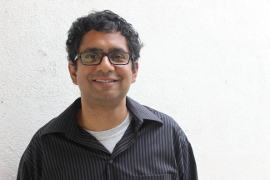Dr. Akash Gulyani
Probing cellular dynamics and neural regeneration
Employing a highly collaborative, interdisciplinary and team-driven approach, we seek to address the mechanisms that control cell fate and behavior using fluorescent imaging, optical techniques and tailored molecular probes.
Cellular output is very precisely regulated by highly dynamic and interconnected signaling networks. But, how is this precision achieved? Among other ways, the intra-cellular activation of signaling proteins, which make up these networks, is tightly regulated in space and time. An important focus of our research is to build tools which would help visualize, through fluorescence imaging, the precise spatio-temporal dynamics of protein activation in living cells. We then employ these reporters in a systems biology approach (with close collaborators) to help build a quantitative and composite understanding of cell signaling.
We have recently pioneered a new approach of using highly versatile and modular scaffolds to generate fluorescent biosensors that are engineered for live cell imaging of signaling dynamics. The idea is to screen libraries of engineered scaffolds to find binders against specific targets, and then use these binders in a modular fashion to build fluorescent biosensors that can report protein activation. This approach is generally applicable, and multiple sensors can be built using the same design strategy.
We are also setting up a program in using chemical biology and high-throughput imaging to build novel biosensor platforms using small molecule libraries as well. This will significantly broaden the repertoire of probes for different targets. At the same time, we are using multiple imaging modalities to enhance biosensor specificity and sensitivity. More broadly though, we are always seeking new ways to build tools for cell biology, with the motto – if there is a fluorescent signal, there is information!
Our quest for new tools is essentially driven by our interest in addressing basic questions in cell biology, with a special focus on cell migration and cell adhesion (binding of cells to extra-cellular proteins). These processes play critical roles in development, homeostasis and regeneration along with diseases such as cancer, inflammation and heart ailments. We are specifically looking at how key signaling proteins like the Src family kinases regulate adhesion initiation, turnover and plasticity. In collaboration with other colleagues at inStem, we are also applying fluorescent reporters to build a quantitative understanding of migration and adhesion signaling in epithelial and stem cell biology.
We have initiated exciting new research in close collaboration with other members of the TAS team in using optical probes and imaging to understand cell migration and tissue remodeling in emerging models of regeneration, hydra and planaria. Cell migration and adhesion dynamics are a critical part of any process of regeneration and in this context - hydra and planaria (with their remarkable regenerative abilities) can serve as excellent model systems to help understand the basic mechanisms associated with tissue remodeling and stem cell fate determination.
The collaborative institutional environment, interconnectedness within research teams and the ability to leverage the collective expertise available within the TAS team and inStem/NCBS makes this effort particularly rewarding and exciting for us.



